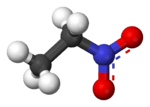Nitroethane
| |||
 | |||
| Names | |||
|---|---|---|---|
| IUPAC name
nitroethane | |||
| Identifiers | |||
| 79-24-3 | |||
| 3D model (Jmol) | Interactive image | ||
| ChEBI | CHEBI:16268 | ||
| ChEMBL | ChEMBL15625 | ||
| ChemSpider | 6338 | ||
| ECHA InfoCard | 100.001.081 | ||
| KEGG | C01837 | ||
| PubChem | 6587 | ||
| RTECS number | KI5600000 | ||
| UN number | UN 2842 | ||
| |||
| |||
| Properties | |||
| C2H5NO2 | |||
| Molar mass | 75.07 g/mol | ||
| Density | 1.054 g/cm3, liquid | ||
| Melting point | −90 °C (−130 °F; 183 K) | ||
| Boiling point | 112.0 to 116.0 °C (233.6 to 240.8 °F; 385.1 to 389.1 K) | ||
| slightly soluble (4.6 g/100 ml at 20 °C) | |||
| Vapor pressure | 21 mmHg (25°C)[1] | ||
| Acidity (pKa) | 16.7[2][3] | ||
| Viscosity | 0.677 Pa·s at 20 °C | ||
| Hazards | |||
| Main hazards | Flammable, harmful | ||
| Safety data sheet | MSDS at fishersci.com | ||
| R-phrases | R5 R10 R22 | ||
| S-phrases | S41 | ||
| Flash point | 28 °C (82 °F; 301 K) | ||
| Explosive limits | 3.4%-?[1] | ||
| Lethal dose or concentration (LD, LC): | |||
| LC50 (median concentration) |
5000 ppm (rabbit, 2 hr)[4] | ||
| LCLo (lowest published) |
6250 ppm (mouse, 2 hr)[4] | ||
| US health exposure limits (NIOSH): | |||
| PEL (Permissible) |
TWA 100 ppm (310 mg/m3)[1] | ||
| REL (Recommended) |
TWA 100 ppm (310 mg/m3)[1] | ||
| IDLH (Immediate danger) |
1000 ppm[1] | ||
| Related compounds | |||
| Related nitro compounds |
2-Nitropropane nitromethane 1,1-dichloro-1-nitroethane | ||
| Related compounds |
ethyl nitrite ethyl nitrate | ||
| Except where otherwise noted, data are given for materials in their standard state (at 25 °C [77 °F], 100 kPa). | |||
| | |||
| Infobox references | |||
Nitroethane is an organic compound having the chemical formula C2H5NO2. Similar in many regards to nitromethane, nitroethane is an oily liquid at standard temperature and pressure. Pure nitroethane is colourless and has a fruity odor.
Preparation
Nitroethane is produced industrially by treating propane with nitric acid at 350–450 °C. This exothermic reaction produces four industrially significant nitroalkanes: nitromethane, nitroethane, 1-nitropropane, and 2-nitropropane. The reaction involves free radicals, such as CH3CH2CH2O., which arise via homolysis of the corresponding nitrite ester. These alkoxy radicals are susceptible to C—C fragmentation reactions, which explains the formation of a mixture of products.[5]
Alternatively, nitroethane can be produced by the Victor Meyer reaction with either bromoethane or iodoethane with silver nitrite in a diethyl ether solvent or with the Kornblum Modification which uses the prior mentioned alkyl halides with the less soluble sodium nitrite salt in either a dimethyl sulfoxide or dimethylformamide solvent.[6]
Uses
Via condensations like the Henry reaction, nitroethane converts to several compounds of commercial interest. Condensation with 3,4-dimethoxybenzaldehyde affords the precursor to the antihypertensive drug methyldopa; condensation with unsubstituted benzaldehyde yields phenyl-2-nitropropene. Nitroethane condenses with two equivalents of formaldehyde to give, after hydrogenation, 2-amino-2-methyl-1,3-propanediol, which in turn condenses with oleic acid to give an oxazoline, which protonates to give a cationic surfactant.[5]
Like some other nitrated organic compounds, nitroethane is also used as a fuel additive and a precursor to explosives.
Nitroethane is a useful solvent for polymers such as polystyrene and is particularly useful for dissolving cyanoacrylate adhesives. In niche applications, it has been used as a component in artificial nail remover and in overhead ceiling sealant sprays.
Toxicity
Nitroethane is suspected to cause genetic damage and be harmful to the nervous system. Typical TLV/TWA is 100 ppm. Typical STEL is 150 ppm. Skin contact causes dermatitis in humans. In animal studies, nitroethane exposure was observed to cause lacrimation, dyspnea, pulmonary rales, edema, liver and kidney injury, and narcosis.[7] Children have been poisoned by accidental ingestion of artificial nail remover.[8]
The LD50 for rats is reported as 1100 mg/kg.[9]
References
- 1 2 3 4 5 "NIOSH Pocket Guide to Chemical Hazards #0453". National Institute for Occupational Safety and Health (NIOSH).
- ↑ Reich, Hans. "Bordwell pKa table: "Nitroalkanes"". University of Wisconsin Chemistry Department. Retrieved 17 January 2016.
- ↑ Matthews, Walter; et al. (1975). "Equilibrium acidities of carbon acids. VI. Establishment of an absolute scale of acidities in dimethyl sulfoxide solution". Journal of the American Chemical Society. 97 (24): 7006. doi:10.1021/ja00857a010. Retrieved 17 January 2016.
- 1 2 "Nitroethane". Immediately Dangerous to Life and Health. National Institute for Occupational Safety and Health (NIOSH).
- 1 2 Sheldon B. Markofsky “Nitro Compounds, Aliphatic” Ullmann's Encyclopedia of Industrial Chemistry, Wiley-VCH, Weinheim, 2002. doi:10.1002/14356007.a17_401.
- ↑ Agrawal, Jai (2007). Organic Chemistry of Explosives. Chichester, England: John Wiley & Sons. pp. 7–10. ISBN 9780470029671.
- ↑ "Chemical Sampling Information Nitroethane." Retrieved February 9, 2007, from the website of the US Occupational Safety & Health Administration.
- ↑ Hornfeldt CS, Rabe WH (1994). "Nitroethane poisoning from an artificial fingernail remover". J. Toxicol. Clin. Toxicol. 32 (3): 321–4. doi:10.3109/15563659409017967. PMID 8007041.
- ↑ MSDS for nitroethane (revised October 3, 2005), as reported by Fisher Scientific.
